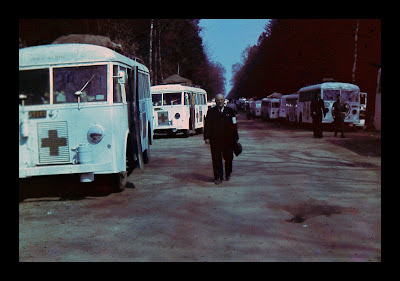The President of the USA gets a call from the CIA:
Mr. President, Russians landed on the moon and started to paint it red. Shall we act?
No, just wait.
New call, after some months:
Mr. President, Russians are working very hard, half of the moon is now painted, shall we act?
No, just wait
A few months later another CIA call to Donald Trump:
Mr. President, 95% of the moon is now painted, shall we act?
No, wait until it is fully covered in red and just paint Coca-Cola white on it. This way we will get a lot of money from the Coca-Cola company.
A friend of mine told me this joke a few years ago. Since that. I was always connecting the Coca-Cola story with Mr. Folke Bernadotte. I thought that it quite accurately illustrates how he used the White Bus mission to create his own, new image, in Europe. His image was of course as well, the image of Sweden, so important in post-war Europe. He painted the red moon, white and left the symbol of the red crosses unpainted. His entire procedure can be followed in his own book Slutet.
As the Russian and Allied forces approached Germany at the end of 1944, SHAEF decided what should be done regarding Allied prisoners in Germany. Within the Norwegian government, Major Johan Koren Christie wrote a memorandum on September 23; the Norwegian prisoners should "stay put", and wait until they were liberated by the advancing Allied and Russian forces.
However, besides the Stay-put recommendation, the Danes obtained a German permit to retrieve the first group of 231 prisoners. The first ones transported back to Denmark were Danish policemen from the concentration camp Buchenwald. The first Danish transport, using four red DSB buses started on December 5. Until the end of February 1945, the Danes transported 341 prisoners home, most of them ill. These journeys gave the Danes valuable experience in how to perform this type of action.
Starting in February 1945 Allied air blows paralyzed communications throughout the length and breadth of Germany and powerful elements of the Red Army consolidated bridgeheads and regrouped along the Oder while significant advances were made by forces on the flanks.
In March the massive offensive in the west reached the Rhine from Koblenz to the Dutch border. Dashing to seize a usable bridge overlooked by the enemy, United States troops crossed the broad river at Remagen. In the Saar, a coordinated offensive was launched to destroy the remaining German forces west of the Rhine. Later in March Crossing, the Rhine River allowed US and British troops to advance into the interior of Germany. Bergen-Belsen truce talks, between British and German troops, started probably during the first week of April.
The small corridor between Sovjet and Allied troops that was constantly attacked became one of the most dangerous areas in the entire of Europe. However, Mr. Bernadotte decided that this small corridor between Sovjet and Allied should be used for transports of the Scandinavian inmates from the concentration camps.
 |
| Red Moon as seen from my camera. |
 |
| No comments |
 |
| Swedish military buses were used in the common White bus mission. |
 |
| Frontiers in Europe at the end of March and the beginning of April 1945. |

